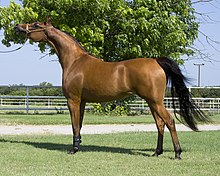
Back Arabierperd AF خيل عربية Arabic Caballu árabe AST Ərəb atı AZ Ғәрәп аты BA Araber-Roß BAR Арабски кон Bulgarian আরবীয় ঘোড়া Bengali/Bangla Cavall àrab Catalan Arabský plnokrevník Czech
 An Arabian mare | |
| Other names | Arabian, Arab |
|---|---|
| Country of origin | Developed in the Middle East, most notably Arabian peninsula |
| Distribution | Worldwide from Middle East and North Africa origins[1] |
| Traits | |
| Weight |
|
| Height |
|
| Color | Bay, black, chestnut, or gray. Occasional dominant white, sabino, or rabicano patterns. |
| Distinguishing features | Finely chiseled bone structure, concave profile, arched neck, comparatively level croup, high-carried tail. |
The Arabian or Arab horse (Arabic: الحصان العربي [alħisˤaːn alʕarabijj], DMG al-ḥiṣān al-ʿarabī) is a breed of horse with historic roots on the Arabian Peninsula. With a distinctive head shape and high tail carriage, the Arabian is one of the most easily recognizable horse breeds in the world. It is also one of the oldest modern breeds. Although modern DNA cannot trace breed purity in the modern population beyond 200 years, there is archaeological evidence of horses in the Middle East with landrace characteristics that resemble modern Arabians dating back 3,500 years. Throughout history, Arabian horses have spread around the world by both war and trade, used to improve other breeds by adding speed, refinement, endurance, and strong bone. Today, Arabian bloodlines are found in almost every modern breed of riding horse.
The Arabian developed in a desert climate and was prized by the nomadic Bedouin people, often being brought inside the family tent for shelter and protection from theft. Selective breeding for traits, including an ability to form a cooperative relationship with humans, created a horse breed that is good-natured, quick to learn, and willing to please. The Arabian also developed the high spirit and alertness needed in a horse used for raiding and war. This combination of willingness and sensitivity requires modern Arabian horse owners to handle their horses with competence and respect.
The Arabian is a versatile breed. Arabians dominate the discipline of endurance riding and compete today in many other fields of equestrian sport. They are one of the top ten most popular horse breeds in the world. They are now found worldwide, including the United States and Canada, the United Kingdom, Australia, continental Europe, South America (especially Brazil), and their land of origin, the Middle East.
- ^ Chaiklin, Martha; Gooding, Philip; Campbell, Gwyn (July 21, 2020). Animal Trade Histories in the Indian Ocean World. Springer Nature. p. 130. ISBN 978-3-030-42595-1.